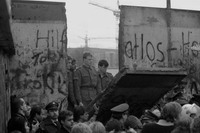Login form
Cold War

would blow up the world. Now the Cold War has faded to a distant memory.
The Cold War was a conflict primarily between the United States and the Soviet Union. Each power brought other countries into the conflict on its side. The Cold War lasted more than 40 years, from the mid-1940s to the end of the 1980s.
Why was the war “cold”? Because the United States and the Soviet Union never got into armed combat—a shooting or “hot” war—with each other.
HOW DID THE COLD WAR BEGIN?
The Cold War began soon after World War II ended in 1945. The United States and the Soviet Union had been allies (friends) in defeating Nazi Germany in that war. The Soviet army had invaded Germany from the east.
After the war, the Soviet Union kept control of countries in Eastern Europe that it had freed from German control. Those countries included Bulgaria, Czechoslovakia, Hungary, Poland, and Romania.
An iron curtain fell across Europe. That’s how Winston Churchill, Britain’s leader during World War II, described the division of Europe. There was no actual curtain, but there were strong barriers between Soviet-controlled Eastern Europe and largely democratic Western Europe. The Soviet Union insisted on that.
Barbed wire and armed soldiers at borders kept Eastern Europe separate from Western Europe during the Cold War. Defeated Germany was split into East Germany under Soviet control, and West Germany. Berlin, Germany’s former capital, was a divided city. In 1961, a concrete wall went up in Berlin, along the dividing line. Broken glass on top of the Berlin Wall kept people from going over it and escaping to West Germany.
WHAT WAS THE CONFLICT ABOUT?
During the Cold War, the Soviet Union and the United States had different political and economic systems. The Soviet system was called communism. The United States and its allies feared that the Soviet Union wanted to spread communism to the rest of the world. They disliked this system.
The goal of communism was to end private ownership of property. Under communism, the people would own everything communally (jointly). They would make decisions as a group.
But things didn’t work out that way in the Soviet Union. Instead, the country became a dictatorship under the control of the Communist Party. Many freedoms were lost. Millions of people who disagreed with the Communist Party were arrested and sent to prison camps.
The United States and most of the countries of Western Europe had democratic governments rather than dictatorships. They valued freedoms that had been lost in the Soviet Union. Their economic system—capitalism—was based on private ownership and on individual rather than group effort.
At times during the Cold War, the United States lost some freedoms because of fear of communism. During the 1950s, many Americans who were suspected of sympathy for communism lost their jobs.
WHAT WAS THE ARMS RACE?
During the Cold War, each side built up its arsenal of weapons, especially nuclear weapons—atomic bombs and hydrogen bombs. These weapons could destroy cities and kill hundreds of thousands of people. Each side was afraid the other would start a nuclear war first.
A nuclear arms race began. Each side said it needed more weapons to retaliate (fight back) in case of a nuclear attack. Both sides believed that if they had enough weapons the other side wouldn't dare start a nuclear war. If it did, it would face total destruction in retaliation.
HOW DID THE COLD WAR SPREAD?
The Soviet Union had put Communist governments in power in Eastern Europe. Communist leaders had come to power in China. The Soviet Union and China backed groups that tried to take power in other countries. Wars broke out. The United States entered wars to stop the spread of communism.
With the Korean War (1950-1953), the Cold War reached Asia. China backed North Korea, and the United States supported South Korea. Korea was still divided when fighting stopped in 1953, and it remains divided today.
In 1962, the Cold War brought the world to the edge of nuclear war. The United States discovered that the Soviet Union had installed nuclear missiles in Cuba. The missiles were pointed at the United States. War seemed certain, but the Soviet Union backed down and removed the missiles.
The United States fought the spread of communism in the Vietnam War (1959-1975). The U.S. government feared that if one Asian country fell to communism, the rest of Asia would become communist as well. The war ended with a communist victory in Vietnam. But communism did not spread throughout Asia.
HOW DID THE COLD WAR END?
The Soviet Union nearly went broke as a result of the Cold War weapons race. The Soviet people had given up hope of a better life ahead. In the mid-1980s, a new leader came to power in the Soviet Union, Mikhail Gorbachev. Gorbachev was determined to improve life in his country. In the process, he helped bring the Cold War to an end.
Gorbachev called for more freedom for his people. He and U.S. president Ronald Reagan agreed to destroy many of the weapons their countries had built. Gorbachev encouraged change in Eastern Europe, and he said that Soviet troops would no longer keep communist governments in power there.
One after another, the countries of Eastern Europe got rid of their communist leaders. In 1989, the Berlin Wall came down. Europe was no longer divided. Finally, parts of the Soviet Union declared their independence. The Cold War ended with the collapse of communism in Eastern Europe in 1989, and the breakup of the Soviet Union in 1991.
Source: Microsoft ® Encarta

